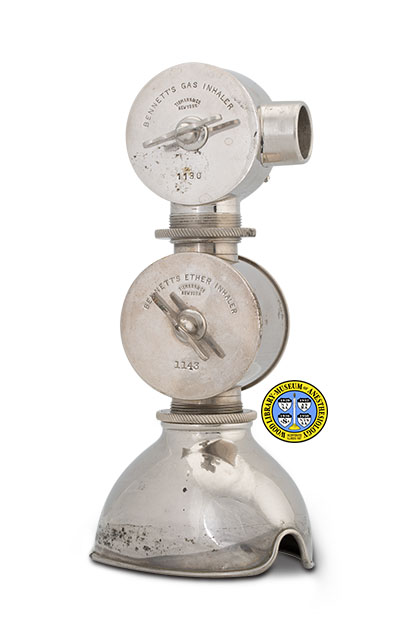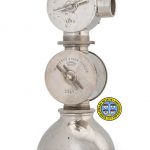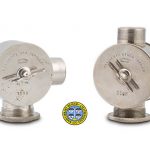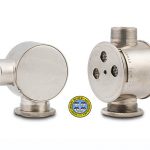Bennett Gas & Ether Inhaler
New York physician Thomas L. Bennett, M.D. (1868-1932) was a student of Sir Frederic W. Hewitt (1857-1916), the leading British anesthesiologist. He invented an ether inhaler, a look-alike inhaler for gas (nitrous oxide) and a third inhaler that combined them in a "piggyback" configuration. He introduced all three together in one article published in 1900. When new, the mask would have had a rubber rim for a better seal and more comfortable fit. The ether inhaler would have been packed with gauze as a medium for the liquid anesthetic. Whether used alone or in tandem, the gas inhaler would have been connected to a rubber rebreathing bag; this added some of the patient's exhaled carbon dioxide to the anesthetic. The amount of fresh air admitted to the patient could be controlled by adjusting a sliding cover on each cylinder. Bennett inhalers were made by several firms and continued in use through the 1930s. The example shown here was made by the original manufacturer, Geo. Tiemann & Co.
Catalog Record: Bennett Gas & Ether Inhaler Bennet Gas & Ether Inhaler
Access Key: aqsg
Accession No.: 2018-01-16-2
Title: Bennett gas inhaler / [designed by Thomas L. Bennett].
Author: Bennett, Thomas L., d. 1932.
Corporate Author: George Tiemann & Co.
Title variation: Alt Title
Title: Bennett’s combined gas and ether inhaler.
Publisher: New York : George Tiemann & Co., [between 1900 and ca. 1940].
Physical Description: 1 inhaler chamber : metals ; 8 x 6 x 8 cm.
Subject: Anesthesia, Inhalation – instrumentation.
Subject: Inhalers, Anesthesia.
Subject: Nitrous Oxide – administration and dosage.
Note Type: General
Notes: The first year in the range of possible dates of manufacture is based on the year of introduction. The second year in the date range is based on the date of the latest contemporary description found by the cataloger.
When the three parts of the Bennett Gas and Ether Inhaler are connected to one another, the mask is on the bottom, the ether inhaler screws into the top of the mask, and the connector on the bottom of the gas inhaler slips over the chimney on top of the ether inhaler.
Described from the patient’s point of view. The notched “nasal end” of the mask is considered the front.
Illustrations of the Bennett Gas and Ether Inhaler vary. In the original, 1900 description, the ether inhaler is situated so that the dial faces front and the thumb screw faces right, while the gas inhaler is situated so that the air aperture faces front and the thumb screw faces right. Also in this description, the right side of the mask has an adjustable valve, called an “air tap”. In Tiemann’s 1926 catalog, no knob can be seen on either of the inhalers, and no valve can be seen on the mask.
When the cataloged ether inhaler is screwed finger tight into the cataloged mask, the thumb screw faces left. The gas inhaler does not screw into the ether inhaler; it can be turned 360 degrees. The cataloged mask does not have a valve.
Note Type: General
Notes: The complete gas inhaler, as a stand-alone apparatus, would also have a mask, an angled connector, a rubber rebreathing bag and a rubber rim.
Note Type: With
Notes: Married to Acc. # 753 and Acc. # 2018-01-16-1 for purposes of photography. When the three pieces are connected to one another, the apparatus measures approximately 21.5 x 9 x 12 centimeters.
Note Type: Citation
Notes: Allen F. Recent methods in the administration of anesthetics. Dental Cosmos. September, 1904;46:9, 742.
Note Type: Citation
Notes: Bennett TL. New anaesthetic apparatus. Medical Record. March 24, 1900;57(12):524-527.
Note Type: Citation
Notes: Betcher AM. History and development of anaesthetic liquid vaporizers. In: Boulton TB, et al., eds. Progress in Anaesthesiology: Proceedings of the Fourth World Congress of Anaesthesiologists, London, September 9th-13th, 1968. Amsterdam: Excerpta Medica Foundation, 1970:217.
Note Type: Citation
Notes: Dogliotti AM. Anesthesia: Narcosis, Local, Regional, Spinal. Chicago: S. B. Debour, Publishers, 1939:186-187.
Note Type: Citation
Notes: Flagg PJ. The Art of Anaesthesia. Philadelphia: J. B. Lippincott Company, 1916:138-140.
Note Type: Physical Description
Notes: One inhaler chamber; Consists of a cylinder with an air aperture on the front, a connector on the bottom and another connector on the back; The connector on the bottom is threaded on the exterior, so that it can be screwed into a mask; There is a threaded metal ring on this connector; A sliding metal band inside the cylinder has openings that align with both the front aperture and the back connector; The position of this band is controlled by a thumb screw on the right side of the cylinder; When this band is set so that it closes the front aperture, it opens the back connector; When it is set so that it opens the front aperture, it closes the connector in back; The left side disc is unmarked; The right side disc is marked: “BENNETT’S GAS INHALER [new line] TIEMANN & CO. [new line] NEW YORK [new line] 1130”; The thumb screw is in the center of this disc.
Note Type: Reproduction
Notes: Photographed by Mr. Steve Donisch, January 16, 2018.
Note Type: Historical
Notes: New York physician Thomas L. Bennett, M.D. (d. 1932), invented an ether inhaler, a look-alike inhaler for gas (nitrous oxide), and a third inhaler that combined them in a “piggyback” configuration. He was a student of Sir Frederic W. Hewitt (1857-1916), the leading British anesthesiologist (Betcher.) Bennett introduced all three of his inhalers together in one article published in 1900. In this article he promised his readers that he would “examine each inhaler when it is made, and when it is found perfect will issue a certificate to that effect.” George Tiemann & Company was the original manufacturer. Competitors Kny-Scheerer Company and the George Ermold Company soon followed suit. Each of these medical instrument makers was based in New York City. George Tiemann & Co. is still doing business today. Bennett’s inhalers continued in use through the 1930s.
When new, the mask would have had a rubber rim for a better seal and more comfortable fit. The ether inhaler would have been packed with gauze as a medium for the liquid anesthetic. Whether used alone or in tandem, the gas inhaler would have been connected to a rubber rebreathing bag; this added some of the patient’s exhaled carbon dioxide to the anesthetic. Fresh air was admitted to the patient through openings in the cylinder. The amount of air could be controlled by adjusting a sliding cover.
Note Type: Publication
Notes: Bennett TL. The amount of the anesthetic. JAMA. March 24, 1900;34(12):706-708.
Note Type: Publication
Notes: Bennett TL. Chloroform, ether and other anaesthetic agents, administration. In: Reference Handbook of Medical Sciences, Vol 3. New York: William Wood, 1901.
Note Type: Publication
Notes: Bennett TL. Remarks on general anaesthesia in operations involving the upper air passages. Laryngoscope. April, 1903;1394):262-267.
Note Type: Exhibition
Notes: Selected for the WLM website.
Access Key: aqsh
Accession No.: 2018-01-16-1
Title: Bennett ether inhaler / [designed by Thomas L. Bennett].
Author: Bennett, Thomas L., d. 1932.
Corporate Author: George Tiemann & Co.
Title variation: Alt Title
Title: Bennett’s combined gas and ether inhaler.
Publisher: New York : George Tiemann & Co., [between 1900 and 1940].
Physical Description: 1 inhaler chamber : metals, gauze ; 9 x 6.5 x 6.5 diameter cm.
Subject: Anesthesia, Inhalation – instrumentation.
Subject: Ether, Ethyl.
Subject: Inhalers, Anesthesia.
Note Type: General
Notes: The first year in the range of possible dates of manufacture is based on the year of introduction. The second year in the date range is based on the date of the latest contemporary description found by the cataloger.
When the three parts of the Bennett Gas and Ether Inhaler are connected to one another, the mask is on the bottom, the ether inhaler screws into the top of the mask, and the connector on the bottom of the gas inhaler slips over the chimney on top of the ether inhaler.
Described from the patient’s point of view. The notched “nasal end” of the mask is considered the front.
Illustrations of the Bennett Gas and Ether Inhaler vary. In the original, 1900 description, the ether inhaler is situated so that the dial faces front and the thumb screw faces right, while the gas inhaler is situated so that the air aperture faces front and the thumb screw faces right. Also in this description, the right side of the mask has an adjustable valve, called an “air tap”. In Tiemann’s 1926 catalog, no knob can be seen on either of the inhalers, and no valve can be seen on the mask.
When the cataloged ether inhaler is screwed finger tight into the cataloged mask, the thumb screw faces left. The gas inhaler does not screw into the ether inhaler; it can be turned 360 degrees. The cataloged mask does not have a valve.
Note Type: General
Notes: The complete ether inhaler, as a stand-alone apparatus, would also have a mask, an angled connector, a rubber rebreathing bag and a rubber rim.
Note Type: With
Notes: Married to Acc. # 753 and Acc. # 2018-01-16-2 for purposes of photography. When the three pieces are connected to one another, the apparatus measures approximately 21.5 x 9 x 12 centimeters.
Note Type: Citation
Notes: Allen F. Recent methods in the administration of anesthetics. Dental Cosmos. September, 1904;46:9:742.
Note Type: Citation
Notes: Bennett TL. New anaesthetic apparatus. Medical Record. March 24, 1900;57(12):524-527.
Note Type: Citation
Notes: Betcher AM. History and development of anaesthetic liquid vaporizers. In: Boulton TB, et al., eds. Progress in Anaesthesiology: Proceedings of the Fourth World Congress of Anaesthesiologists, London, September 9th-13th, 1968. Amsterdam: Excerpta Medica Foundation, 1970:217.
Note Type: Citation
Notes: Dogliotti AM. Anesthesia: Narcosis, Local, Regional, Spinal. Chicago: S. B. Debour, Publishers, 1939:186-187.
Note Type: Citation
Notes: Flagg PJ. The Art of Anaesthesia. Philadelphia: J. B. Lippincott Company, 1916:138-140.
Note Type: Physical Description
Notes: One inhaler chamber; Consists of a cylinder with a threaded connector in the bottom and another, unthreaded connector in the top; There is a threaded ring around the bottom connector; The cylinder measures approximately 6.5 centimeters in diameter; In the left side disc there are four air apertures that reveal a wire screen inside that retains gauze packing material; The same wire screen and gauze can be seen through the top connector; A control lever on the front side of the cylinder is marked: “AIR ETHER”; This lever operates an internal disc that can be used to cover some portion or all of the air apertures; The right side disc is marked: “BENNETT’S ETHER INHALER [new line] TIEMANN & CO. [new line] NEW YORK [new line] 1143”; In the center of this side, between the name and the serial number, there is a threaded opening that holds a thumb screw.
Note Type: Reproduction
Notes: Photographed by Mr. Steve Donisch, January 16, 2018.
Note Type: Historical
Notes: New York physician Thomas L. Bennett, M.D. (d. 1932), invented an ether inhaler, a look-alike inhaler for gas (nitrous oxide), and a third inhaler that combined them in a “piggyback” configuration. He was a student of Sir Frederic W. Hewitt (1857-1916), the leading British anesthesiologist (Betcher.) Bennett introduced all three of his inhalers together in one article published in 1900. In this article he promised his readers that he would “examine each inhaler when it is made, and when it is found perfect will issue a certificate to that effect.” George Tiemann & Company was the original manufacturer. Competitors Kny-Scheerer Company and the George Ermold Company soon followed suit. Each of these medical instrument makers was based in New York City. George Tiemann & Co. is still doing business today. Bennett’s inhalers continued in use through the 1930s.
When new, the mask would have had a rubber rim for a better seal and more comfortable fit. The ether inhaler would have been packed with gauze as a medium for the liquid anesthetic. Whether used alone or in tandem, the gas inhaler would have been connected to a rubber rebreathing bag; this added some of the patient’s exhaled carbon dioxide to the anesthetic. Fresh air was admitted to the patient through openings in the cylinder. The amount of air could be controlled by adjusting a sliding cover.
Note Type: Publication
Notes: Bennett TL. The amount of the anesthetic. JAMA. March 24, 1900;34(12):706-708.
Note Type: Publication
Notes: Bennett TL. Chloroform, ether and other anaesthetic agents, administration. In: Reference Handbook of Medical Sciences, Vol 3. New York: William Wood, 1901.
Note Type: Publication
Notes: Bennett TL. Remarks on general anaesthesia in operations involving the upper air passages. Laryngoscope. April, 1903;1394):262-267.
Note Type: Exhibition
Notes: Selected for the WLM website.
Access Key: aqsi
Accession No.: 753
Title: [Bennett inhaler mask] / [designed by Thomas L. Bennett].
Author: Bennett, Thomas L., d. 1932.
Corporate Author: George Tiemann & Co.
Title variation: Alt Title
Title: Bennett’s combined gas and ether inhaler.
Publisher: New York : George Tiemann & Co., [between 1900 and 1940].
Physical Description: 1 face mask : metals ; 6 x 9 x 12 cm.
Subject: Anesthesia, Inhalation – instrumentation.
Subject: Inhalers, Anesthesia.
Note Type: General
Notes: The first year in the range of possible dates of manufacture is based on the year of introduction. The second year in the date range is based on the date of the latest contemporary description found by the cataloger.
When the three parts of the Bennett Gas and Ether Inhaler are connected to one another, the mask is on the bottom, the ether inhaler screws into the top of the mask, and the connector on the bottom of the gas inhaler slips over the chimney on top of the ether inhaler.
Described from the patient’s point of view. The notched “nasal end” of the mask is considered the front.
Illustrations of the Bennett Gas and Ether Inhaler vary. In the original, 1900 description, the ether inhaler is situated so that the dial faces front and the thumb screw faces right, while the gas inhaler is situated so that the air aperture faces front and the thumb screw faces right. Also in this description, the right side of the mask has an adjustable valve, called an “air tap”. In Tiemann’s 1926 catalog, no knob can be seen on either of the inhalers, and no valve can be seen on the mask.
When the cataloged ether inhaler is screwed finger tight into the cataloged mask, the thumb screw faces left. The gas inhaler does not screw into the ether inhaler; it can be turned 360 degrees. The cataloged mask does not have a valve.
Note Type: With
Notes: Married to Acc. # 2018-01-16-1 and Acc. # 2018-01-16-2 for purposes of photography. When the three pieces are connected to one another, the apparatus measures approximately 21.5 x 9 x 12 centimeters.
Note Type: Citation
Notes: Allen F. Recent methods in the administration of anesthetics. Dental Cosmos. September, 1904;46:9:742.
Note Type: Citation
Notes: Bennett TL. New anaesthetic apparatus. Medical Record. March 24, 1900;57(12):524-527.
Note Type: Citation
Notes: Betcher AM. History and development of anaesthetic liquid vaporizers. In: Boulton TB, et al., eds. Progress in Anaesthesiology: Proceedings of the Fourth World Congress of Anaesthesiologists, London, September 9th-13th, 1968. Amsterdam: Excerpta Medica Foundation, 1970:217.
Note Type: Citation
Notes: Dogliotti AM. Anesthesia: Narcosis, Local, Regional, Spinal. Chicago: S. B. Debour, Publishers, 1939:186-187.
Note Type: Citation
Notes: Flagg PJ. The Art of Anaesthesia. Philadelphia: J. B. Lippincott Company, 1916:138-140.
Note Type: Physical Description
Notes: The notch in the “nasal end” is approximately 2 centimeters high and 3 centimeters wide; There is a threaded opening in the top of the mask; This opening is approximately 3 centimeters in diameter; This opening bears the painted accession number: “753”; This number is hidden when the ether inhaler is in place; Black residue has been left by the absent rubber rim; Some dents and scratches.
Note Type: Reproduction
Notes: Photographed by Mr. Steve Donisch, January 16, 2018.
Note Type: Historical
Notes: New York physician Thomas L. Bennett, M.D. (d. 1932), invented an ether inhaler, a look-alike inhaler for gas (nitrous oxide), and a third inhaler that combined them in a “piggyback” configuration. He was a student of Sir Frederic W. Hewitt (1857-1916), the leading British anesthesiologist (Betcher.) Bennett introduced all three of his inhalers together in one article published in 1900. In this article he promised his readers that he would “examine each inhaler when it is made, and when it is found perfect will issue a certificate to that effect.” George Tiemann & Company was the original manufacturer. Competitors Kny-Scheerer Company and the George Ermold Company soon followed suit. Each of these medical instrument makers was based in New York City. George Tiemann & Co. is still doing business today. Bennett’s inhalers continued in use through the 1930s.
When new, the mask would have had a rubber rim for a better seal and more comfortable fit. The ether inhaler would have been packed with gauze as a medium for the liquid anesthetic. Whether used alone or in tandem, the gas inhaler would have been connected to a rubber rebreathing bag; this added some of the patient’s exhaled carbon dioxide to the anesthetic. Fresh air was admitted to the patient through openings in the cylinder. The amount of air could be controlled by adjusting a sliding cover.
Note Type: Publication
Notes: Bennett TL. The amount of the anesthetic. JAMA. March 24, 1900;34(12):706-708.
Note Type: Publication
Notes: Bennett TL. Chloroform, ether and other anaesthetic agents, administration. In: Reference Handbook of Medical Sciences, Vol 3. New York: William Wood, 1901.
Note Type: Publication
Notes: Bennett TL. Remarks on general anaesthesia in operations involving the upper air passages. Laryngoscope. April, 1903;1394):262-267.
Note Type: Exhibition
Notes: Selected for the WLM website.




